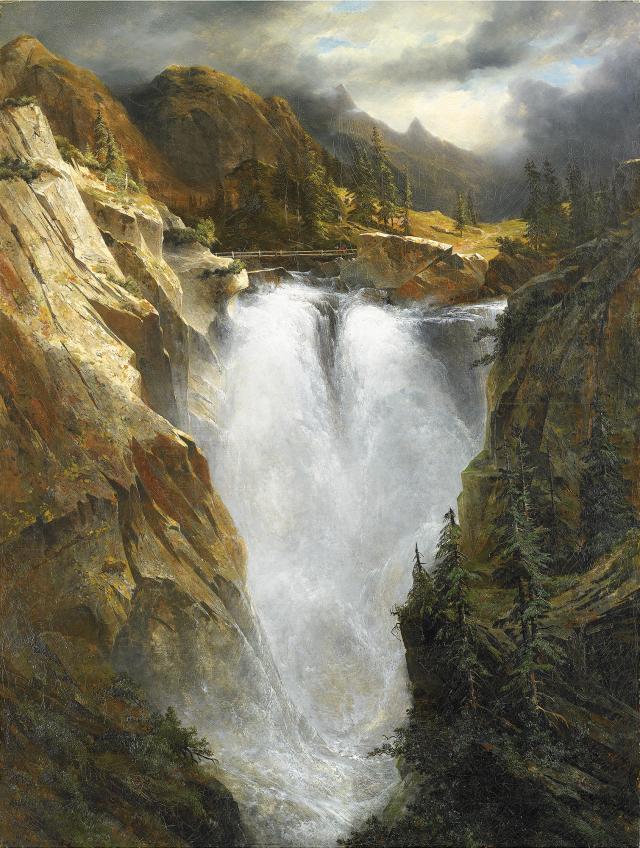In 1835 Lady Osborne commissioned Alexandre Calame to paint a view of the Handeck waterfall. To honour her request, the artist sets off for this wild and remote region of Switzerland, nestled in the Alps’ high upper valleys. Calame is looking to paint studies in the open air that will help him execute Lady Osborne’s picture and so, between 1835 and1839, he makes two separate stays in a chalet in the Bernese Oberland.
This sumptuous region, the archetype of the heroic Swiss landscape, will provide the inspiration for the artist’s best-known masterpiece and the painting that will make his name, Orage à la Handeck (Thunderstorm in Handeck), a canvas dating from 1839, the same year that Calame completes the oil painting commissioned by Lady Osborne.
The Irish aristocrat was one of Calame's first admirers and important clients; it was she who gave the painter access to upper-class circles in Europe and America. Lady Osborne had taken quite a fancy to Switzerland’s majestic landscapes and wanted the artist to compose for her a painting of the famous spectacular falls whose plentiful waters come crashing down in a powerful burst of sparkle and spray.
Assuming a vertical format with a symmetrical V-shaped composition, the Cascade de la Handeck presents an overhead glimpse of one of the most exceptional waterfalls in Switzerland, affording viewers a dizzying impression of plunging right into the depths of the precipice. Calame depicts a hard and unforgiving land of sharp rocks and scraggy pines, a static scene that is brought to life by the fury of the Handeck’s tumultuous waters.
Along with the naturalist description of the landscape and notably the care he lavishes on the rendering of the mists rising from the churning gorges, Calame takes great pains in working his light effects. The drama of the scene oscillates between the dark threatening mass of clouds, harbingers of a coming storm, and the bright misty explosion springing up from the hollow in the mountain, and to heighten this drama he constructs clear, theatrical oppositions, mirroring the unpredictable lighting of the foreboding mountain and its sharply defined contrasts.
In the finest romantic spirit, the artist captures the quintessence of a grandiose landscape where a nature untamed by man seems to answer to no one. The sole token of human activity, the small wooden bridge and the minuscule travellers on foot looking down on the gorges below, appears quite fragile before the majesty of the landscape’s features and a valley that is all movement and swirling vapour, and in which a raging torrent springs forcefully to life.
This sumptuous region, the archetype of the heroic Swiss landscape, will provide the inspiration for the artist’s best-known masterpiece and the painting that will make his name, Orage à la Handeck (Thunderstorm in Handeck), a canvas dating from 1839, the same year that Calame completes the oil painting commissioned by Lady Osborne.
The Irish aristocrat was one of Calame's first admirers and important clients; it was she who gave the painter access to upper-class circles in Europe and America. Lady Osborne had taken quite a fancy to Switzerland’s majestic landscapes and wanted the artist to compose for her a painting of the famous spectacular falls whose plentiful waters come crashing down in a powerful burst of sparkle and spray.
Assuming a vertical format with a symmetrical V-shaped composition, the Cascade de la Handeck presents an overhead glimpse of one of the most exceptional waterfalls in Switzerland, affording viewers a dizzying impression of plunging right into the depths of the precipice. Calame depicts a hard and unforgiving land of sharp rocks and scraggy pines, a static scene that is brought to life by the fury of the Handeck’s tumultuous waters.
Along with the naturalist description of the landscape and notably the care he lavishes on the rendering of the mists rising from the churning gorges, Calame takes great pains in working his light effects. The drama of the scene oscillates between the dark threatening mass of clouds, harbingers of a coming storm, and the bright misty explosion springing up from the hollow in the mountain, and to heighten this drama he constructs clear, theatrical oppositions, mirroring the unpredictable lighting of the foreboding mountain and its sharply defined contrasts.
In the finest romantic spirit, the artist captures the quintessence of a grandiose landscape where a nature untamed by man seems to answer to no one. The sole token of human activity, the small wooden bridge and the minuscule travellers on foot looking down on the gorges below, appears quite fragile before the majesty of the landscape’s features and a valley that is all movement and swirling vapour, and in which a raging torrent springs forcefully to life.
